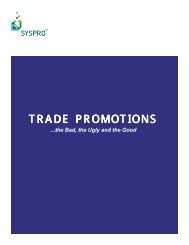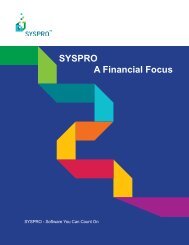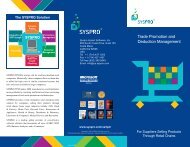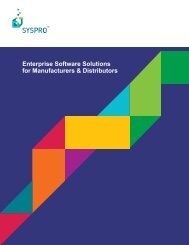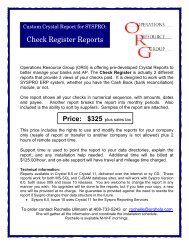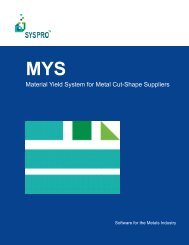Teach Yourself e.net - Syspro
Teach Yourself e.net - Syspro
Teach Yourself e.net - Syspro
You also want an ePaper? Increase the reach of your titles
YUMPU automatically turns print PDFs into web optimized ePapers that Google loves.
More Advanced Options<br />
instead if you are more experienced in XSLT and are more comfortable using it.<br />
Two more items must be included within an XSLT document that follows the guidelines<br />
found in the XSLT specification. These are a local namespace declaration and the<br />
"version" attribute. The following stylesheet file shows the xsl:stylesheet element, the<br />
namespace declaration, and the version attribute:<br />
Example 6.6. XSL Simple Stylsheet File<br />
<br />
<br />
<br />
<br />
The namespace URI (http://www.w3.org/1999/XSL/Transform) is always listed exactly as<br />
shown, and the version attribute should have a value of 1.0 for the document to conform to<br />
the November 1999 XSLT specification (which all XML and XSL used by SYSPRO e.<strong>net</strong><br />
solutions does). As future versions of the specification are released, this version number<br />
can be changed, depending on what features the XSLT document uses.<br />
XSLT version 2.0 was in Candidate Recommendation at the time this chapter<br />
was written. All the examples used in this book use XSLT version 1.0.<br />
6.1.4.2. Other XSLT Elements<br />
If you have experience in programming in HTML you will already know how HTML<br />
elements are used to perform specific tasks. For example, you know that the <br />
element is used with the and elements to construct a table for display in a<br />
browser. You know that the element is used to display an image, and that the <br />
element is used as to define different page locations and divisions. In HTML, each of these<br />
elements have a specific purpose. Each of the elements of XSLT has a specific purpose as<br />
well.<br />
The XSLT version 1.0 specification lists the elements that are used to transform XML<br />
documents. The elements can be used in many different ways. They can be used as to<br />
perform programming logic, performing if/then statements, looping, and writing out data<br />
within a node. They can also be used to determine the output format. An XSLT element is<br />
6–9




